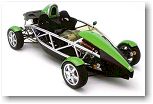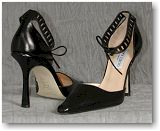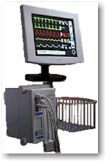|

|
What is
aesthetics?
The term 'aesthetics'
concerns our senses and our responses to an object. If something
is aesthetically pleasing to you, it is 'pleasurable' and you
like it. If it is aesthetically displeasing to you, it is
'displeasurable' and you don't like it. Aesthetics
involves all of your senses - vision, hearing, touch, taste, and
smell - and your emotions.
|
 |
| Elements
of Aesthetics
There are
many different things that contribute to your overall
perception of a product, and to your opinion as to
whether it is aesthetically pleasing to you.
|
| Vision |
Hearing |
Touch |
Taste |
Smell |
Colour
Shape
Pattern
Line
Texture
Visual weight
Balance
Scale
Movement |
Loudness
Pitch
Beat
Repetition
Melody
Pattern
Noise |
Texture
Shape
Weight
Give
Comfort
Temperature
Vibration
Sharpness
Ease of use |
Strength
Sweetness
Sourness
Texture |
Strength
Sweetness
'Pleasantness' |
Your opinion about a product may also be influenced by
certain associations
that are important to you, such as:
- how fashionable it
is
- whether it is a
novelty, or an old favourite
- whether it is a
symbol of wealth or love
- how much danger or
risk is involved
- if it provides a
link with your past
You might also take
into account whether it is safe and reliable and fit for
its purpose.
|
 |
Consistency
with a particular aesthetic concept may be a significant
factor in creating a product's appeal too, for example,
the current appreciation of 'retro' designs.
However, such trends are often cultural and almost
certainly always short-lived, so their popularity can't
be guaranteed.
|
|
|
Consideration of aesthetics in design |
|
There are four different 'pleasure types' to consider:
|

Physio-pleasure - pleasure derived from the senses from touch, smell,
sensual pleasure
etc. For example the smoothness of a curve in a hand-held product or the smell of a new car.

|
|

Socio-pleasure - pleasure gained from interaction with others. This may be a
'talking point' product like a special ornament or
painting, or the product may be the focus of a social gathering
such as a vending machine or coffee machine. This pleasure can also
come from a product that represents a social grouping,
for example, a particular style of clothing that gives
you a social identity.

|
|

Psycho-pleasure - pleasure from the satisfaction felt when a task is successfully completed.
Pleasure also comes from the extent to which the product makes
the task more pleasurable, such as the interface of an ATM
cash machine, that is quick and simple to use. It is closely related to product
usability.

|
|

Ideo-pleasure - pleasure derived from entities such as books, art and music.
This is the most abstract pleasure. In terms of products, it is the values that a product embodies,
such as a product that is made of eco-friendly materials, and processes that
convey a sense of environmental responsibility to the user.

|
Each of these pleasures should be considered in turn - their importance to the product you are designing, and how each aspect might
show itself in that product.
|
|
adapted by Patrick Jordan
from the work of sociologist Lionel Tiger |
|
|

|
|
Aesthetics and ergonomics in product design |
| |
"More and more people buy objects
for intellectual and spiritual nourishment. People do not buy my
coffee makers, kettles and lemon squeezers because they need to
make coffee, to boil water, or to squeeze lemons, but for other
reasons."
Alberto Alessi, Designer
|
|
| This
quote gives an
indication of how the world of product design has changed over
the past few decades. An appreciation of pleasure in product use
is fast becoming of primary importance to both consumer and the
design industry alike. Consumers' expectations have been
raised; they no longer simply expect the products they buy to be
functional and usable. Consumers demand functionality, expect
usability and are seeking products that that elicit other
feelings such as pleasure or that strike a certain emotional
chord. It likely to be the aesthetics of the product; the way it
looks, the feel of the material, the tactile or 'haptic' response
of controls or more abstract feelings, such as reflected status, that give pleasure.
Traditionally, product design has been
considered to comprise three main elements:

|
Product Designers need a
knowledge of all these elements. In the case of the design of a
small or simple product,
the designer's responsibility may be for all of these
elements. In the case of larger products, such as cars, the
designer's responsibility may be for aesthetics only;
ergonomists and engineers providing the expertise needed for the
other elements.
Conventionally, ergonomics has consisted of
usability and functionality, and designing pleasure into the
product has been the job of the designer. However, increasingly
the boundaries between the two disciplines are disappearing, and
ergonomists are taking some responsibility for the aesthetics of
the design, using scientific methods to increase understanding of the aesthetics (both pleasurable and
displeasurable) and applying this to the design of products.
The best design occurs when all three components are considered
together from the start of the design process. Usually,
compromises will have to be made, but understanding all the
issues involved will help to make the most acceptable
compromises. For example, if you are
designing a sports car, you will make different compromises from
those that you will make if you are designing a family saloon
car.
|
| Sports car
 The emphasis is on aesthetics and performance. The car may go very fast, look beautiful and make all the
right sort of noises.
However, it is likely to be difficult to get in and out of, have little
storage space, seat only two people and have limited visibility. The physical and functional ergonomics are not the
best but the car is exactly what the consumer is expecting of a
sports car. Ergonomics is compromised in order to achieve
performance and aesthetics. The emphasis is on aesthetics and performance. The car may go very fast, look beautiful and make all the
right sort of noises.
However, it is likely to be difficult to get in and out of, have little
storage space, seat only two people and have limited visibility. The physical and functional ergonomics are not the
best but the car is exactly what the consumer is expecting of a
sports car. Ergonomics is compromised in order to achieve
performance and aesthetics.
|
| Family
saloon car
 The emphasis is on functionality and usability. The car should first serve the needs of the family, so will have adequate seating and
storage space and be suitable for family travelling. It should
also have aesthetic appeal but there may be compromises in design in order to provide the required levels of functionality and
usability. The emphasis is on functionality and usability. The car should first serve the needs of the family, so will have adequate seating and
storage space and be suitable for family travelling. It should
also have aesthetic appeal but there may be compromises in design in order to provide the required levels of functionality and
usability.
|
 |
|
|
Working with aesthetics and ergonomics |
 |
Compromises need to be made in different ways depending upon the product.
Where ergonomics and aesthetics meet
Clearly, many aesthetic ideas are easily combined with good ergonomics,
for example, chairs that look good and are
comfortable too; buttons on your mobile phone that give
good feedback. This Alessi corkscrew has obviously been designed to
be more than just a corkscrew, but it is extremely functional as well.
|
 |
Where aesthetics may predominate
There are other products that conflict directly with ergonomics principles.
For example, cars that go so fast they thrill you despite
(or is it because of?) the risk that you are taking. However, whilst speed limits and traffic calming measures exist to slow fast cars down in dangerous situations, these fast, thrilling objects of desire are
still designed and manufactured. Another example of
aesthetics having more influence than ergonomics is shoes that are
beautiful and very fashionable, but are bad for your
feet and your posture, and increase the risk of slipping and hurting yourself.
We are all educated as small children about the need to
wear well-fitting, flat shoes for healthy feet, but we
would complain if all footwear had to be designed by
ergonomic principles only.
|

|
Where aesthetics must never predominate
Conversely, there are situations where ergonomics principles must override aesthetics, such as products that are used in safety-critical situations.
For example, equipment designed for use in operating theatres or by air traffic controllers.
There is much legislation concerning the safety of
products and designers must work within these constraints of legislation or their products will not be allowed to enter the market place.
For more on product safety, see the product
evaluation topic.
Where to compromise
Many products are not safety-critical and the designer must take the responsibility for balancing aesthetics and ergonomics appropriately.
Miniaturisation of products is an example worth considering. When mobile telephones were first designed, technology dictated that they were the size of a small
housebrick! The displays and controls were easily usable by most
people, but they considered
the phones to be too large and heavy to be very 'mobile'.
Technological advances allowed the production of smaller
phones and they became truly 'mobile'; fitting easily into handbags and
pockets. However, the control and display sizes were compromised
and many have become too small for easy use. The optimum compromise was not recognised.
|
|
|